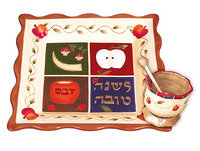The Many Traditions of Rosh HaShanah
2015 Aug 9th
 It’s almost cliché to repeat Tevye’s
attempt to distill how the Ashkenazi Jews of Fiddler on the Roof—and really Jews as a whole—have “kept their
balance” throughout the years, and yet in the case of Rosh Hashanah, the word
“Tradition!” rings as loud and true as can be.
It’s almost cliché to repeat Tevye’s
attempt to distill how the Ashkenazi Jews of Fiddler on the Roof—and really Jews as a whole—have “kept their
balance” throughout the years, and yet in the case of Rosh Hashanah, the word
“Tradition!” rings as loud and true as can be.
We have a way of exaggerating things greatly nowadays, especially when it comes to time—“Oy, the bus took ages to come!” or “The Maple Leafs are taking just ages to rebuild…I’m telling you, it’s hopeless.”
And while it’s been a while since the Toronto area has seen a Stanley Cup winner, as it is currently the year 5775 by the Hebrew Calendar, which governs, among other things, when Rosh Hashanah and all other major Jewish holidays are held, it’s safe to say that Rosh Hashanah has marked “the Jewish New Year” for, well, literally ages. As with any long-running event, there are many traditions associated with Rosh Hashanah, which yourholylandstore.com is happy to guide you through.
Some of the most important Rosh Hashanah traditions include:
- The traditional Hebrew greeting for the occasion, “Shanah Tovah,” which translates to “A Good Year.”
- Rosh Hashanah is also often linked or associated with Yom Kippur, the Day of Atonement and holiest day on the Hebrew Calendar. As such, there are many religious traditions which surround Rosh Hashanah and the process of there being a “new year;” for some Jews, the event marks the day God inscribes upon the Book of Life the fates of all individuals. Naturally, this gravitas, and the atonement that comes with Yom Kippur, lends a great deal of solemnity and tradition to the occasion.
- The length of a Rosh Hashanah celebration or commemoration can vary depending on the form of Judaism to which you adhere. The Hebrew calendar marks days in terms of sunsets, rather than actual midnight. As such, depending on where in the week the holiday falls, Orthodox Jews may observe and pray for one or two days according to the Georgian calendar so as to match up with the sunset-to-sunset routine of the Hebrew one. This is in part to ensure a greater amount of time for everyone to attend to the religious ceremonies associated with this “day of judgment” and the aforementioned theology concerning the Book of Life. Reform and secular Jews generally just observe Rosh Hashanah for one day.
- While it is in many ways a very spiritual day, there is plenty of room for secular fun in a Rosh Hashanah celebration. Food preferences date back to Biblical times, and have been traditionally influenced by, among other things, where in the Diaspora Jewish communities lived. A Rosh Hashanah feast is generally the highlight of the holiday so far as the merry aspect of the occasion is concerned, and said feast can consist of everything from gefilte fish and Eastern European delicacies to more spicy, Sephardic foods. Apples and honey—which are used to denote what is hopefully a “sweet” year to come—are popular foods throughout the Jewish community on Rosh Hashanah.
These are just a few of the many traditions that go into one of Judaism’s oldest and most prominent holidays.

